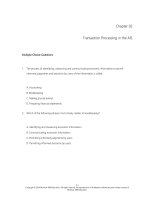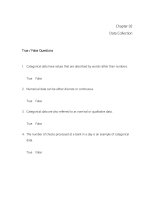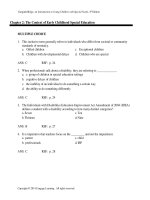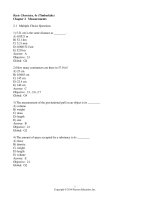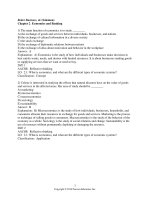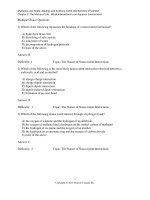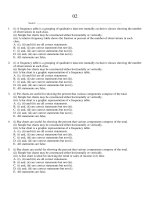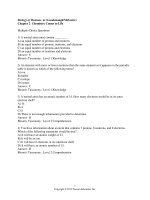Public speaking handbook 4th edition beebe test bank
Bạn đang xem bản rút gọn của tài liệu. Xem và tải ngay bản đầy đủ của tài liệu tại đây (438.29 KB, 15 trang )
Test Bank
for
Public Speaking Handbook
Fourth Edition
Prepared by
Joy Daggs
Culver-Stockton College
Boston Columbus Indianapolis New York San Francisco Upper Saddle River
Amsterdam Cape Town Dubai London Madrid Milan Munich Paris Montreal Toronto
Delhi Mexico City Sao Paulo Sydney Hong Kong Seoul Singapore Taipei Tokyo
Copyright © 2013, 2010, 2007 by Pearson Education, Inc.
All rights reserved. Manufactured in the United States of America. The contents, or parts thereof,
may be reproduced with Public Speaking Handbook, Fourth Edition, by Steven A. Beebe and
Susan J. Beebe provided such reproductions bear copyright notice, but may not be reproduced in
any form for any other purpose without written permission from the copyright owner.
To obtain permission(s) to use material from this work, please submit a written request to
Pearson Education, Inc., Permissions Department, One Lake Street, Upper Saddle River, New
Jersey 07458, or you may fax your request to 201-236-3290.
1 2 3 4 5 6 7 8 9 10—OPM—15 14 13 12
ISBN-10: 0-205-85687-X
www.pearsonhighered.com
ISBN-13: 978-0-205-85687-9
TABLE OF CONTENTS
Test Bank Chapter 1: Introduction to Public Speaking ............................................................ 2
Test Bank Chapter 2: Speaking with Confidence ....................Error! Bookmark not defined.
Test Bank Chapter 3: Speaking Freely and Ethically ..............Error! Bookmark not defined.
Test Bank Chapter 4: Listening to Speeches .............................Error! Bookmark not defined.
Test Bank Chapter 5: Analyzing Your Audience .....................Error! Bookmark not defined.
Test Bank Chapter 6: Developing Your Speech........................Error! Bookmark not defined.
Test Bank Chapter 7: Gathering and Using Supporting Material........ Error! Bookmark not
defined.
Test Bank Chapter 8: Organizing Your Speech .......................Error! Bookmark not defined.
Test Bank Chapter 9: Introducing Your Speech ......................Error! Bookmark not defined.
Test Bank Chapter 10: Concluding Your Speech ....................Error! Bookmark not defined.
Test Bank Chapter 11: Outlining and Editing Your Speech ...Error! Bookmark not defined.
Test Bank Chapter 12: Using Words Well: Speaker Language and Style .. Error! Bookmark
not defined.
Test Bank Chapter 13: Delivering Your Speech .......................Error! Bookmark not defined.
Test Bank Chapter 14: Designing and Using Presentation Aids ........... Error! Bookmark not
defined.
Test Bank Chapter 16: Understanding Principles of Persuasive Speaking Error! Bookmark
not defined.
Test Bank Chapter 17: Using Persuasive Strategies .................Error! Bookmark not defined.
Test Bank Chapter 18: Speaking for Special Occasions and Purposes Error! Bookmark not
defined.
1
Copyright © 2013, 2010, 2007 Pearson Education, Inc. All Rights Reserved.
Test Bank Chapter 1: Introduction to Public Speaking
1.1 Multiple Choice
1.1.1.
Having the resources, information, and attitudes that lead to action in
achieving a desired goal is
a. an action plan.
b. empowerment.
c. self-confidence.
d. organization.
2
Page Ref:
Why study public speaking?
Topic:
Answer: b. empowerment.
1.1.2.
Which of the following skills learned in a public-speaking course are among
the skills most sought after by an employer?
a. ethically adapting information to listeners
b. organizing ideas
c. persuading others
d. holding listeners' attention
e. all of the above
3
Page Ref:
Why study public speaking?
Topic:
Answer : e. all of the above
1.1.3.
According to several recent studies quoted in your text, the most important
skills employers are seeking in college graduates are
a. enthusiasm and work experience.
b. good speaking and presentation skills.
c. technical and competence in the work area.
d. attractive appearance and poise.
3
Page Ref:
Why study public speaking?
Topic:
Answer: b. good speaking and presentation skills.
2
Copyright © 2013, 2010, 2007 Pearson Education, Inc. All Rights Reserved.
Test Bank for Public Speaking Handbook, Fourth Edition
1.1.4.
An example of how the nonverbal communication of public speakers is more
formal than nonverbal behavior in ordinary conversation is that people
engaged in ordinary conversation
a. often sit or stand further apart.
b. gesture spontaneously.
c. plan their movements and avoid moving about restlessly.
d. both A and C
e. all of the above
4
Page Ref:
Public speaking & conversation
Topic:
Answer: b. gesture spontaneously.
1.1.5.
One way public speaking and conversation are similar is that both are
a. formal.
b. planned.
c. audience-centered.
d. less fluid.
4
Page Ref:
Public speaking & conversation, public speaking is formal
Topic:
Answer: c. audience-centered.
1.1.6.
In his speech about volunteering for the American Red Cross, Jacob used a
lot of slang words, sat and leaned on the table in front of the class, and was
dressed very casually. Which of the following statements best describes this
situation?
a. Jacob adapted to his audience by making his speech more informal.
b. Jacob violated the audience's space by sitting and leaning on the table in front
of class.
c. Jacob ignored the rule that public speaking is more formal than conversation.
d. Jacob did nothing wrong by approaching this topic in a casual manner.
4
Page Ref:
Public speaking & conversation, public speaking is formal
Topic:
Answer: c. Jacob ignored the rule that public speaking is more formal than
conversation.
1.1.7.
Translating ideas and images in the speaker's mind into verbal or
nonverbal messages that an audience can understand is termed
a. feedback.
b. decoding.
c. encoding.
d. listening.
4
Page Ref:
Communication as action, source
Topic:
Answer: c. encoding.
3
Copyright © 2013, 2010, 2007 Pearson Education, Inc. All Rights Reserved.
Test Bank for Public Speaking Handbook, Fourth Edition
1.1.8.
During a speech, an audience member stands up and asks a question, to
everyone's surprise. According to your text, is the audience member's
behavior appropriate?
a. Yes; question and answer sessions are quite common in public speaking.
b. No; the audience member should have remained seated to ask his or her
question.
c. No; the audience member did not maintain clearly defined roles of speaker
and listener.
d. Yes; in this day and age of informality, speakers should expect audiences to
respond out loud.
4
Page Ref:
Roles of public speakers and audiences are clearly defined
Topic:
Answer: c. No; the audience member did not maintain clearly defined roles of
speaker and listener.
1.1.9.
An audience member is worried about an upcoming exam and is unlikely to
remember much of what the speaker says. This is a type of
a. external noise.
b. internal noise.
c. physical noise.
d. educational noise.
5
Page Ref:
Communication as action, noise
Topic:
Answer: b. internal noise.
1.1.10.
During the first day of speeches you had a bad sinus infection and your
ears were plugged so you couldn't hear the speakers. You were
experiencing
a. physical noise.
b. physiological noise.
c. psychological noise.
d. pseudo noise.
5
Page Ref:
Communication as action, noise
Topic:
Answer: b. physiological noise.
1.1.11.
The environment or situation in which a speech occurs is known as
a. feedback.
b. a channel.
c. communication.
d. context.
6
Page Ref:
Communication as interaction, context
Topic:
Answer: d. context.
4
Copyright © 2013, 2010, 2007 Pearson Education, Inc. All Rights Reserved.
Test Bank for Public Speaking Handbook, Fourth Edition
1.1.12.
A speaker transmits a message through two channels:
a. visual and nonverbal.
b. voice and inflection.
c. visual and auditory.
d. auditory and eye contact.
5
Page Ref:
Communication as action, channels
Topic:
Answer: c. visual and auditory.
1.1.13.
The context of a public-speaking experience includes such elements as
a. the time.
b. the place.
c. the speaker's cultural traditions and expectations.
d. the audience's cultural traditions and expectations.
e. all of the above.
6
Page Ref:
Communication as interaction
Topic:
Answer: e. all of the above.
1.1.14.
Smiles, head nods, eye contact, and clapping from audience members are
all forms of
a. encoding.
b. decoding.
c. internal noise.
d. feedback.
6
Page Ref:
Communication as interaction, feedback
Topic:
Answer: d. feedback.
1.1.15.
This is another term for the use of words and symbols to achieve a goal.
a. transaction
b. declamation
c. interaction
d. rhetoric
8
Page Ref:
The rich heritage of public speaking
Topic:
Answer : d. rhetoric
5
Copyright © 2013, 2010, 2007 Pearson Education, Inc. All Rights Reserved.
Test Bank for Public Speaking Handbook, Fourth Edition
1.1.16.
If you delivered an already famous address of the British orator Edmund
Burke, you would be practicing the art of
a. declamation.
b. interpretation.
c. oration.
d. elocution.
12
Page Ref:
The rich heritage of public speaking
Topic:
Answer: a. declamation.
1.1.17.
This is the expression of emotion through posture, movement, gestures,
facial expression, and voice.
a. declamation
b. elocution
c. rhetoric
d. transaction
8
Page Ref:
The rich heritage of public speaking
Topic:
Answer : b. elocution
1.1.18.
Which of the following is an example of the new era of speech making in
the 21st century?
a. Listening to a speaker at a town meeting.
b. A soldier watching her son’s graduation address via Skype.
c. Someone re-enacting the “I have a Dream” speech
d. The President giving the “State of the Union” address
9
Page Ref:
Public speaking today
Topic:
Answer: b. A soldier watching her son’s graduation address via Skype.
1.1.19.
Which of these is NOT a way in which public speaking differs from
conversation?
a. public speaking is planned; conversation is spontaneous
b. public speaking is informal; conversation is formal
c. public speaking roles are clearly defined; conversational roles are fluid
d. public speaking is formal; conversation is informal
5
Page Ref:
Public Speaking and Conversation
Topic:
Answer : b. public speaking is informal; conversation is formal
6
Copyright © 2013, 2010, 2007 Pearson Education, Inc. All Rights Reserved.
Test Bank for Public Speaking Handbook, Fourth Edition
1.1.20.
Sam got up to give his speech in public speaking class. He began walking
around the audience, high-fiving his classmates and began his speech
saying, "Hey! What up Dawgs?" What difference between conversation
and public speaking did Sam NOT understand?
a. public speaking is more formal than conversation
b. public speaking requires planning
c. the roles of the audience and speaker are clearly defined in public speaking
d. Nothing; Sam’s behavior was just fine.
5
Page Ref:
Public Speaking and Conversation
Topic:
Answer : a. public speaking is more formal than conversation
1.1.21.
Which of the communication models depicts the roles of sender and
receiver as fluid and constantly changing?
a. communication as action
b. communication as reaction
c. communication as transaction
d. communication as interaction
7
Page Ref:
Communication as Transaction
Topic:
Answer : c. communication as transaction
1.1.22.
Which of the following is an example of declamation?
a. Someone performing the Gettysburg Address
b. Someone getting up and talking about Abraham Lincoln's life
c. Someone giving a public response to Barack Obama's inauguration speech
d. Singing the National anthem
8
Page Ref:
Rich Heritage of Public Speaking
Topic:
Answer : a. Someone performing the Gettysburg Address
1.1.23.
Which of the following is the most important element of the public
speaking process, according to your text?
a. audience
b. speaker
c. manuscript
d. podium
13-15
Page Ref:
Diverse Audiences
Topic:
Answer : a. audience
7
Copyright © 2013, 2010, 2007 Pearson Education, Inc. All Rights Reserved.
Test Bank for Public Speaking Handbook, Fourth Edition
1.1.24.
Churches services that encourage call-and-response speaker audience
interaction is seemingly in violation of which of the differences between
public speaking and conversation?
a. Public speaking is more prepared than conversation
b. Public speaking is also more formal than conservation
c. Public Speaking involves more clearly defined roles for the speaker and
audience.
d. None of these
4
Page Ref:
Communication during public speaking and conversation
Topic:
Answer : C. Public Speaking involves more clearly defined roles for the
speaker and audience
1.1.25.
Fred and Sally are having lunch, catching up on their day. Each person
takes turns telling stories and then listening to the other. This is an
example of which communication model?
a. Communication as action
b. Communication as interaction
c. Communication as reaction
d. Communication as transaction
4-7
Page Ref:
Public Speaking as a Communication process
Topic:
Answer: d. Communication as transaction
1.2 Fill in the Blank
1.2.1.
The __________ of a public-speaking experience is the environment or
situation in which the speech occurs.
6
Page Ref:
Communication as interaction, context
Topic:
Answer : a. context
1.2.2.
A message is usually transmitted from sender to receiver via two
channels: visual and __________.
5
Page Ref:
Communication as action, channels
Topic:
Answer : a. auditory
1.2.3.
Slang and other types of language are not acceptable in public speaking
because it is more
__________ than conversation.
4
Page Ref:
Public Speaking and Conversation
Topic:
Answer : a. formal
8
Copyright © 2013, 2010, 2007 Pearson Education, Inc. All Rights Reserved.
Test Bank for Public Speaking Handbook, Fourth Edition
1.3 True and False
1.3.1.
Public speaking is more formal than conversation.
a. True
b. False
4
Page Ref:
Public speaking & conversation, public speaking is formal
Topic:
Factual
Skill:
Answer : a. True
1.3.2.
People in conversation may alternately talk and listen, and don't interrupt
one another, but in public speaking the roles of speaker and audience aren't
as clearly defined.
a. true
b. false
5
Page Ref:
Roles of public speakers and audiences are clearly defined
Topic:
Answer : b. False
1.3.3.
The receiver of the message is the individual audience member, whose
decoding of the message depends on the other audience members receiving
the message and their past experiences.
a. true
b. false
5
Page Ref:
Communication as action, receiver
Topic:
Answer : b. False
1.3.4.
Elocution is the expression of emotion through posture, movement, gestures,
facial expression, and voice.
a. true
b. false
8
Page Ref:
The rich heritage of public speaking
Topic:
Answer : a. True
1.3.5.
Elocution is the delivery of an already famous speech.
a. true
b. false
8
Page Ref:
The rich heritage of public speaking
Topic:
Answer : b. False
9
Copyright © 2013, 2010, 2007 Pearson Education, Inc. All Rights Reserved.
Test Bank for Public Speaking Handbook, Fourth Edition
1.3.6.
Public speaking in the 21st century does not draw on the traditions of public
speaking in any way.
a. True
b. False
9
Page Ref:
Public speaking today
Topic:
Answer : a. False
1.3.7.
The audience should be the last thing a speaker should consider when
planning a speech.
a. True
b. False
9-10
Page Ref:
Audience Centered public speaking
Topic:
Answer : b. False
1.3.8.
Conversation has more clearly defined roles of speaker and listener than
public speaking.
a. True
b. False
4
Page Ref:
Public Speaking and Conversation
Topic:
Answer : b. False
1.3.9.
The Communication as Interaction model includes the element of feedback.
a. True
b. False
10
Page Ref:
Communication Models
Topic:
Answer : a. True
1.3.10.
In the Communication as Transaction model, the roles of receiver and
source are changed simultaneously.
a. True
b. False
6
Page Ref:
Communication as Transaction
Topic:
Answer : a. True
10
Copyright © 2013, 2010, 2007 Pearson Education, Inc. All Rights Reserved.
Test Bank for Public Speaking Handbook, Fourth Edition
1.3.11.
Elocution is the use of words and symbols to achieve a goal.
a. True
b. False
8
Page Ref:
The Rich Heritage of Public Speaking
Topic:
Answer : b. False
1.3.12.
Declamation is the performance of an already famous speech.
1
Difficulty:
Question ID: 1.3.12
8
Page Ref:
The Rich Heritage of Public Speaking
Topic:
Answer : a. True
1.3.13.
Public speaking is a process.
a. True
b. False
4
Page Ref:
An introduction to public speaking
Topic:
Answer : a. True
1.3.14.
Noise can only be physical.
a. True
b. False
Page Ref:
Topic:
Skill:
Objective:
Answer : b.
1.3.15.
5
Communication models
Application
False
Speakers should not adapt to diverse audiences.
a. True
b. False
9
Page Ref:
An overview of audience-centered public speaking
Topic:
Answer : b. False
11
Copyright © 2013, 2010, 2007 Pearson Education, Inc. All Rights Reserved.
Test Bank for Public Speaking Handbook, Fourth Edition
1.4 Matching
1.4.1.
Match the following.
source
a. The public speaker.
encode
b. To translate ideas and images
into verbal or nonverbal
symbols.
code
c. A verbal or nonverbal symbol
for an idea or image.
external noise
d. Physical sounds that interfere
with communication.
internal noise
e. Physiological or psychological
interference with
communication.
5-7
Page Ref:
Communication as action
Topic:
Answer : a. source/ b. encode/c. code/ d. external noise/ e. internal noise
1.4.2.
Match the following.
a. rhetoric
b. elocution
c. declamation
the use of words and symbols to
achieve a goal
expression of emotion through
posture, movement, gesture, facial
expression, and voice
delivery of an already famous
speech
new frontiers of public speaking
d. television and streaming
video
8-9
Page Ref:
Rich Heritage of public speaking
Topic:
Answer : a. the use of words and symbols to achieve a goal/ b. expression of
emotion through posture, movement, gesture, facial expression, and voice/ c.
delivery of an already famous speech/ d. new frontiers of public speaking
12
Copyright © 2013, 2010, 2007 Pearson Education, Inc. All Rights Reserved.
Test Bank for Public Speaking Handbook, Fourth Edition
1.5 Essay
5.0.1
What does it mean to be "empowered" in public speaking?
2
Page Ref:
Why study public speaking? empowerment
Topic:
Answer: to have the resources, information, and attitudes that allows you to take
action to achieve a desired goal.
5.0.2
List and briefly define the five factors in the "communication as action"
process.
7-8
Page Ref:
The communication process, communication as action
Topic:
Answer :
1) source - the public speaker
2) message - the speech itself -- both what is said and how it is said
3) channels - visual & auditory -- words, vocal cues, nonverbal symbols, &
visual aids
4) receiver - the individual audience member
5) noise - anything that interferes with the communication transaction
13
Copyright © 2013, 2010, 2007 Pearson Education, Inc. All Rights Reserved.
